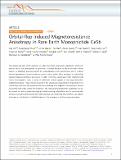Orbital-flop Induced Magnetoresistance Anisotropy in Rare Earth Monopnictide CeSb
Author(s)
Xu, Jing; Wu, Fengcheng; Bao, Jin-Ke; Han, Fei; Xiao, Zhi-Li; Martin, Ivar; Lyu, Yang-Yang; Wang, Yong-Lei; Chung, Duck Young; Li, Mingda; Zhang, Wei; Pearson, John E; Jiang, Jidong S; Kanatzidis, Mercouri G; Kwok, Wai-Kwong; ... Show more Show less
DownloadPublished version (1.286Mb)
Publisher with Creative Commons License
Publisher with Creative Commons License
Creative Commons Attribution
Terms of use
Metadata
Show full item recordAbstract
© 2019, The Author(s). The charge and spin of the electrons in solids have been extensively exploited in electronic devices and in the development of spintronics. Another attribute of electrons—their orbital nature—is attracting growing interest for understanding exotic phenomena and in creating the next-generation of quantum devices such as orbital qubits. Here, we report on orbital-flop induced magnetoresistance anisotropy in CeSb. In the low temperature high magnetic-field driven ferromagnetic state, a series of additional minima appear in the angle-dependent magnetoresistance. These minima arise from the anisotropic magnetization originating from orbital-flops and from the enhanced electron scattering from magnetic multidomains formed around the first-order orbital-flop transition. The measured magnetization anisotropy can be accounted for with a phenomenological model involving orbital-flops and a spin-valve-like structure is used to demonstrate the viable utilization of orbital-flop phenomenon. Our results showcase a contribution of orbital behavior in the emergence of intriguing phenomena.
Date issued
2019Department
Massachusetts Institute of Technology. Department of Nuclear Science and EngineeringJournal
Nature Communications
Publisher
Springer Science and Business Media LLC